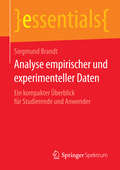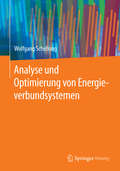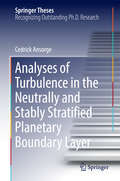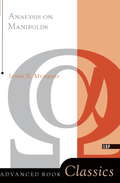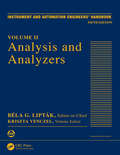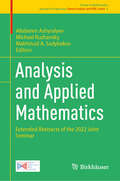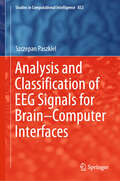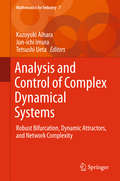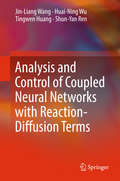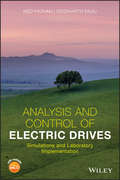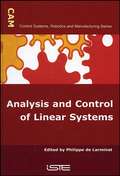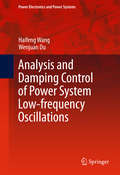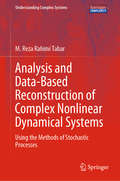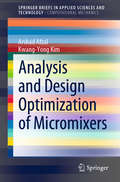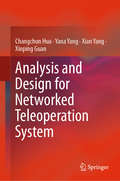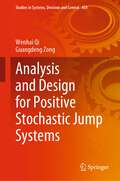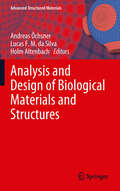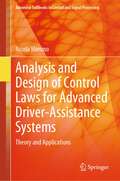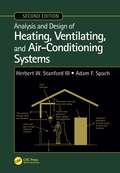- Table View
- List View
Analogue Gravity Phenomenology: Analogue Spacetimes and Horizons, from Theory to Experiment (Lecture Notes in Physics #870)
by Ugo Moschella Vittorio Gorini Sergio Cacciatori Francesco Belgiorno Stefano Liberati Daniele FaccioAnalogue Gravity Phenomenology is a collection of contributions that cover a vast range of areas in physics, ranging from surface wave propagation in fluids to nonlinear optics. The underlying common aspect of all these topics, and hence the main focus and perspective from which they are explained here, is the attempt to develop analogue models for gravitational systems. The original and main motivation of the field is the verification and study of Hawking radiation from a horizon: the enabling feature is the possibility to generate horizons in the laboratory with a wide range of physical systems that involve a flow of one kind or another. The years around 2010 and onwards witnessed a sudden surge of experimental activity in this expanding field of research. However, building an expertise in analogue gravity requires the researcher to be equipped with a rather broad range of knowledge and interests. The aim of this book is to bring the reader up to date with the latest developments and provide the basic background required in order to appreciate the goals, difficulties, and success stories in the field of analogue gravity. Each chapter of the book treats a different topic explained in detail by the major experts for each specific discipline. The first chapters give an overview of black hole spacetimes and Hawking radiation before moving on to describe the large variety of analogue spacetimes that have been proposed and are currently under investigation. This introductory part is then followed by an in-depth description of what are currently the three most promising analogue spacetime settings, namely surface waves in flowing fluids, acoustic oscillations in Bose-Einstein condensates and electromagnetic waves in nonlinear optics. Both theory and experimental endeavours are explained in detail. The final chapters refer to other aspects of analogue gravity beyond the study of Hawking radiation, such as Lorentz invariance violations and Brownian motion in curved spacetimes, before concluding with a return to the origins of the field and a description of the available observational evidence for horizons in astrophysical black holes.
Analogue Quantum Simulation: A New Instrument for Scientific Understanding
by Dominik Hangleiter Jacques Carolan Karim P. ThébaultThis book presents fresh insights into analogue quantum simulation. It argues that these simulations are a new instrument of science. They require a bespoke philosophical analysis, sensitive to both the similarities to and the differences with conventional scientific practices such as analogical argument, experimentation, and classical simulation.The analysis situates the various forms of analogue quantum simulation on the methodological map of modern science. In doing so, it clarifies the functions that analogue quantum simulation serves in scientific practice. To this end, the authors introduce a number of important terminological distinctions. They establish that analogue quantum ‘computation' and ‘emulation' are distinct scientific practices and lead to distinct forms of scientific understanding. The authors also demonstrate the normative value of the computation vs. emulation distinction at both an epistemic and a pragmatic level.The volume features a range of detailed case studies focusing on: i) cold atom computation of many-body localisation and the Higgs mode; ii) photonic emulation of quantum effects in biological systems; and iii) emulation of Hawing radiation in dispersive optical media. Overall, readers will discover a normative framework to isolate and support the goals of scientists undertaking analogue quantum simulation and emulation. This framework will prove useful to both working scientists and philosophers of science interested in cutting-edge scientific practice.
Analyse empirischer und experimenteller Daten: Ein kompakter Überblick für Studierende und Anwender (essentials)
by Siegmund BrandtDiese kompakte Einführung enthält die wichtigsten Grundlagen der mathematischen Statistik, die Beschreibung von Messungen und deren Fehler als Ergebnisse von Stichproben und die Methode der kleinsten Quadrate, angewandt auf verschieden schwierige konkrete Beispiele. Zusätzlich werden kurze Hinweise auf weitere Verfahren der Datenanalyse gegeben.
Analyse und Optimierung von Energieverbundsystemen
by Wolfgang SchellongDas interdisziplin#65533;r aufgebaute Buch bietet kommunalen Energieversorgern Hilfestellung, damit sie ihre Energieverbundsysteme analysieren und optimal steuern lernen. Es gibt einen #65533;berblick #65533;ber den Aufbau und die Komponenten von kommunalen Energieverbundsystemen. Die mathematischen und informationstechnischen Methoden zur Energiesystemanalyse werden umfassend beschrieben und an Praxisbeispielen erl#65533;utert. Es wird gezeigt, wie die Effizienz eines Kraftwerksverbunds mithilfe eines Energiecontrollingsystems analysiert und verbessert werden kann. Die daf#65533;r notwendigen Schritte zum Aufbau eines Energieinformationssystems werden detailliert dargestellt. Auch die mathematischen Methoden zur Analyse und Prognose des Energiebedarfs werden vorgestellt. Es wird gezeigt, wie diese Methoden zur Prognose der Stromlast und des W#65533;rmebedarfs von Fernw#65533;rmesystemen genutzt werden. Aufbauend auf den Erkenntnissen der Energieanalyse werden Optimierungsaufgaben f#65533;r Verbundsysteme abgeleitet und L#65533;sungsans#65533;tze f#65533;r die mathematische Optimierung dargestellt. Das Buch wird abgerundet durch eine zusammenfassende Beschreibung der Anforderungen f#65533;r die Softwareentwicklung eines Energiemanagementsystems.
Analyses of Turbulence in the Neutrally and Stably Stratified Planetary Boundary Layer (Springer Theses)
by Cedrick AnsorgeThis thesis presents a study of strong stratification and turbulence collapse in the planetary boundary layer, opening a new avenue in this field. It is the first work to study all regimes of stratified turbulence in a unified simulation framework without a break in the paradigms for representation of turbulence. To date, advances in our understanding and the parameterization of turbulence in the stable boundary layer have been hampered by difficulties simulating the strongly stratified regime, and the analysis has primarily been based on field measurements. The content presented here changes that paradigm by demonstrating the ability of direct numerical simulation to address this problem, and by doing so to remove the uncertainty of turbulence models from the analysis. Employing a stably stratified Ekman layer as a simplified physical model of the stable boundary layer, the three stratification regimes observed in nature-- weakly, intermediately and strongly stratified--are reproduced, and the data is subsequently used to answer key, long-standing questions. The main part of the book is organized in three sections, namely a comprehensive introduction, numerics, and physics. The thesis ends with a clear and concise conclusion that distills specific implications for the study of the stable boundary layer. This structure emphasizes the physical results, but at the same time gives relevance to the technical aspects of numerical schemes and post-processing tools. The selection of the relevant literature during the introduction, and its use along the work appropriately combines literature from two research communities: fluid dynamics, and boundary-layer meteorology.
Analysis On Manifolds
by James R. MunkresA readable introduction to the subject of calculus on arbitrary surfaces or manifolds. Accessible to readers with knowledge of basic calculus and linear algebra. Sections include series of problems to reinforce concepts.
Analysis On Manifolds
by James R. MunkresA readable introduction to the subject of calculus on arbitrary surfaces or manifolds. Accessible to readers with knowledge of basic calculus and linear algebra. Sections include series of problems to reinforce concepts.
Analysis and Analyzers: Volume II
by Béla G. LiptákThe Instrument and Automation Engineers’ Handbook (IAEH) is the #1 process automation handbook in the world. Volume two of the Fifth Edition, Analysis and Analyzers, describes the measurement of such analytical properties as composition. Analysis and Analyzers is an invaluable resource that describes the availability, features, capabilities, and selection of analyzers used for determining the quality and compositions of liquid, gas, and solid products in many processing industries. It is the first time that a separate volume is devoted to analyzers in the IAEH. This is because, by converting the handbook into an international one, the coverage of analyzers has almost doubled since the last edition. Analysis and Analyzers: Discusses the advantages and disadvantages of various process analyzer designs Offers application- and method-specific guidance for choosing the best analyzer Provides tables of analyzer capabilities and other practical information at a glance Contains detailed descriptions of domestic and overseas products, their features, capabilities, and suppliers, including suppliers’ web addresses Complete with 82 alphabetized chapters and a thorough index for quick access to specific information, Analysis and Analyzers is a must-have reference for instrument and automation engineers working in the chemical, oil/gas, pharmaceutical, pollution, energy, plastics, paper, wastewater, food, etc. industries. About the eBookThe most important new feature of the IAEH, Fifth Edition is its availability as an eBook. The eBook provides the same content as the print edition, with the addition of thousands of web addresses so that readers can reach suppliers or reference books and articles on the hundreds of topics covered in the handbook. This feature includes a complete bidders' list that allows readers to issue their specifications for competitive bids from any or all potential product suppliers.
Analysis and Application of Analog Electronic Circuits to Biomedical Instrumentation (Biomedical Engineering Ser.)
by Robert B. NorthropAnalysis and Application of Analog Electronic Circuits to Biomedical Instrumentation, Second Edition helps biomedical engineers understand the basic analog electronic circuits used for signal conditioning in biomedical instruments. It explains the function and design of signal conditioning systems using analog ICs-the circuits that enable ECG, EEG,
Analysis and Applied Mathematics: Extended Abstracts of the 2022 Joint Seminar (Trends in Mathematics #6)
by Michael Ruzhansky Makhmud A. Sadybekov Allaberen AshyralyevThis book presents extended abstracts of the Analysis and Applied Mathematics seminar organized jointly by Bahçeşehir University, Istanbul, Turkey, Ghent Analysis & PDE Center, Ghent University, Ghent, Belgium and the Institute Mathematics & Math. Modeling, Almaty, Kazakhstan. The book is of value to professional mathematicians as well as advanced students in the fields of analysis and applied mathematics. The goal of the seminar is to provide a forum for researchers and scientists from different regions to communicate their recent developments and to present their original results in various fields of analysis and applied mathematics. All of the articles contain new results and are peer-reviewed. The volume reflects the latest developments in the area of analysis and applied mathematics and their interdisciplinary applications.
Analysis and Classification of EEG Signals for Brain–Computer Interfaces (Studies in Computational Intelligence #852)
by Szczepan PaszkielThis book addresses the problem of EEG signal analysis and the need to classify it for practical use in many sample implementations of brain–computer interfaces. In addition, it offers a wealth of information, ranging from the description of data acquisition methods in the field of human brain work, to the use of Moore–Penrose pseudo inversion to reconstruct the EEG signal and the LORETA method to locate sources of EEG signal generation for the needs of BCI technology. In turn, the book explores the use of neural networks for the classification of changes in the EEG signal based on facial expressions. Further topics touch on machine learning, deep learning, and neural networks. The book also includes dedicated implementation chapters on the use of brain–computer technology in the field of mobile robot control based on Python and the LabVIEW environment. In closing, it discusses the problem of the correlation between brain–computer technology and virtual reality technology.
Analysis and Control for Fractional-order Systems
by Yonggui Kao Yue Cao Changhong Wang Hongwei XiaThis book focuses on the applications of various types of fractional-order differential equations. The authors present their latest research results. This book for the first time introduces the concept of general fractional chaotic systems and their synchronisation, investigates the synchronisation of a fractional coupled reaction-diffusion system using a sliding mode control approach, and considers the impacts of fear and prey escape on a fractional-order prey-predator system with Beddington-DeAngelis functional response. Authors believe that these recent research results can promote the applications of fractional-order differential equations in diverse areas. The book will be attractive to researchers in various fields of mathematics, biomathematics and engineering. Graduate students in related fields may also find this book useful.
Analysis and Control of Boolean Networks: A Semi-tensor Product Approach (Communications and Control Engineering)
by Hongsheng Qi Daizhan Cheng Zhiqiang LiAnalysis and Control of Boolean Networks presents a systematic new approach to the investigation of Boolean control networks. The fundamental tool in this approach is a novel matrix product called the semi-tensor product (STP). Using the STP, a logical function can be expressed as a conventional discrete-time linear system. In the light of this linear expression, certain major issues concerning Boolean network topology - fixed points, cycles, transient times and basins of attractors - can be easily revealed by a set of formulae. This framework renders the state-space approach to dynamic control systems applicable to Boolean control networks. The bilinear-systemic representation of a Boolean control network makes it possible to investigate basic control problems including controllability, observability, stabilization, disturbance decoupling etc.
Analysis and Control of Complex Dynamical Systems: Robust Bifurcation, Dynamic Attractors, and Network Complexity (Mathematics for Industry #7)
by Tetsushi Ueta Kazuyuki Aihara Jun-Ichi ImuraThis book is the first to report on theoretical breakthroughs on control of complex dynamical systems developed by collaborative researchers in the two fields of dynamical systems theory and control theory. As well, its basic point of view is of three kinds of complexity: bifurcation phenomena subject to model uncertainty, complex behavior including periodic/quasi-periodic orbits as well as chaotic orbits, and network complexity emerging from dynamical interactions between subsystems. Analysis and Control of Complex Dynamical Systems offers a valuable resource for mathematicians, physicists, and biophysicists, as well as for researchers in nonlinear science and control engineering, allowing them to develop a better fundamental understanding of the analysis and control synthesis of such complex systems.
Analysis and Control of Coupled Neural Networks with Reaction-Diffusion Terms
by Tingwen Huang Jin-Liang Wang Huai-Ning Wu Shun-Yan RenThis book introduces selected recent findings on the analysis and control of dynamical behaviors for coupled reaction-diffusion neural networks. It presents novel research ideas and essential definitions concerning coupled reaction-diffusion neural networks, such as passivity, adaptive coupling, spatial diffusion coupling, and the relationship between synchronization and output strict passivity. Further, it gathers research results previously published in many flagship journals, presenting them in a unified form. As such, the book will be of interest to all university researchers and graduate students in Engineering and Mathematics who wish to study the dynamical behaviors of coupled reaction-diffusion neural networks.
Analysis and Control of Electric Drives: Simulations and Laboratory Implementation
by Ned Mohan Siddharth RajuA guide to drives essential to electric vehicles, wind turbines, and other motor-driven systems Analysis and Control of Electric Drives is a practical and comprehensive text that offers a clear understanding of electric drives and their industrial applications in the real-world including electric vehicles and wind turbines. The authors—noted experts on the topic—review the basic knowledge needed to understand electric drives and include the pertinent material that examines DC and AC machines in steady state using a unique physics-based approach. The book also analyzes electric machine operation under dynamic conditions, assisted by Space Vectors. The book is filled with illustrative examples and includes information on electric machines with Interior Permanent Magnets. To enhance learning, the book contains end-of-chapter problems and all topics covered use computer simulations with MATLAB Simulink® and Sciamble® Workbench software that is available free online for educational purposes. This important book: Explores additional topics such as electric machines with Interior Permanent Magnets Includes multiple examples and end-of-chapter homework problems Provides simulations made using MATLAB Simulink® and Sciamble® Workbench, free software for educational purposes Contains helpful presentation slides and Solutions Manual for Instructors; simulation files are available on the associated website for easy implementation A unique feature of this book is that the simulations in Sciamble® Workbench software can seamlessly be used to control experiments in a hardware laboratory Written for undergraduate and graduate students, Analysis and Control of Electric Drives is an essential guide to understanding electric vehicles, wind turbines, and increased efficiency of motor-driven systems.
Analysis and Control of Linear Systems (Control Systems, Robotics, And Manufacturing Ser.)
by Philippe De LarminatAutomation of linear systems is a fundamental and essential theory. This book deals with the theory of continuous-state automated systems.
Analysis and Damping Control of Power System Low-frequency Oscillations: Linear Methods (Power Electronics and Power Systems)
by Haifeng Wang Wenjuan DuThis book presents the research and development results on power systems oscillations in three categories of analytical methods. First is damping torque analysis which was proposed in 1960's, further developed between 1980-1990, and widely used in industry. Second is modal analysis which developed between the 1980's and 1990's as the most powerful method. Finally the linearized equal-area criterion analysis that is proposed and developed recently. The book covers three main types of controllers: Power System Stabilizer (PSS), FACTS (Flexible AC Transmission Systems) stabilizer, and ESS (Energy Storage Systems) stabilizer. The book provides a systematic and detailed introduction on the subject as the reference for industry applications and academic research.
Analysis and Data-Based Reconstruction of Complex Nonlinear Dynamical Systems: Using the Methods of Stochastic Processes (Understanding Complex Systems)
by M. Reza Rahimi TabarThis book focuses on a central question in the field of complex systems: Given a fluctuating (in time or space), uni- or multi-variant sequentially measured set of experimental data (even noisy data), how should one analyse non-parametrically the data, assess underlying trends, uncover characteristics of the fluctuations (including diffusion and jump contributions), and construct a stochastic evolution equation?Here, the term "non-parametrically" exemplifies that all the functions and parameters of the constructed stochastic evolution equation can be determined directly from the measured data.The book provides an overview of methods that have been developed for the analysis of fluctuating time series and of spatially disordered structures. Thanks to its feasibility and simplicity, it has been successfully applied to fluctuating time series and spatially disordered structures of complex systems studied in scientific fields such as physics, astrophysics, meteorology, earth science, engineering, finance, medicine and the neurosciences, and has led to a number of important results.The book also includes the numerical and analytical approaches to the analyses of complex time series that are most common in the physical and natural sciences. Further, it is self-contained and readily accessible to students, scientists, and researchers who are familiar with traditional methods of mathematics, such as ordinary, and partial differential equations.The codes for analysing continuous time series are available in an R package developed by the research group Turbulence, Wind energy and Stochastic (TWiSt) at the Carl von Ossietzky University of Oldenburg under the supervision of Prof. Dr. Joachim Peinke. This package makes it possible to extract the (stochastic) evolution equation underlying a set of data or measurements.
Analysis and Design Optimization of Micromixers (SpringerBriefs in Applied Sciences and Technology)
by Kwang-Yong Kim Arshad AfzalThis book illustrates the computational framework based on knowledge of flow and mass transfer together with optimization techniques to solve problems relevant to micromixing technology. The authors provide a detailed analysis of the different numerical techniques applied to the design of micromixers. Flow and mixing analysis is based on both the Eulerian and Lagrangian approaches; relative advantages and disadvantages of the two methods and suitability to different types of mixing problems are analysed. The book also discusses the various facets of numerical schemes subjected to discretization errors and computational grid requirements. Since a large number of studies are based on commercial computational fluid dynamics (CFD) packages, relevant details of these packages to the mixing problem using them are presented. Numerical optimization techniques coupled with CFD analysis of flow and mixing have proved to be an important tool for micromixers design, and therefore, are an important part of the book. These techniques are presented briefly, and focus is on surrogate modeling and optimization applied to design of micromixers.
Analysis and Design for Networked Teleoperation System
by Changchun Hua Xinping Guan Yana Yang Xian YangThis book presents cutting-edge results on stability analysis and control scheme designs for networked teleoperation systems. It highlights new research on commonly encountered nonlinear teleoperation systems, including the stability analysis of teleoperation systems with asymmetric time-varying delays, stability analysis of teleoperation systems with interval time delays, and so on. Moreover, the book presents several high-performance control scheme designs for teleoperation systems when the velocity is available and unavailable, and for systems with nonlinear input. The results presented here mark a substantial contribution to nonlinear teleoperation system theory, robotic control theory and networked control system theory. As such, the book will be of interest to university researchers, R&D engineers and graduate students in control theory and control engineering who wish to learn about the core principles, methods, algorithms, and applications of networked teleoperation systems, robotic systems and nonlinear control systems.
Analysis and Design for Positive Stochastic Jump Systems (Studies in Systems, Decision and Control #450)
by Wenhai Qi Guangdeng ZongThe book focuses on analysis and design for positive stochastic jump systems. By using multiple linear co-positive Lyapunov function method and linear programming technique, a basic theoretical framework is formed toward the issues of analysis and design for positive stochastic jump systems. This is achieved by providing an in-depth study on several major topics such as stability, time delay, finite-time control, observer design, filter design, and fault detection for positive stochastic jump systems. The comprehensive and systematic treatment of positive systems is one of the major features of the book, which is particularly suited for readers who are interested to learn non-negative theory. By reading this book, the reader can obtain the most advanced analysis and design techniques for positive stochastic jump systems.
Analysis and Design of Biological Materials and Structures (Advanced Structured Materials #14)
by Andreas Öchsner Lucas F. Silva Holm AltenbachThis collection provides researchers and scientists with advanced analyses and materials design techniques in Biomaterials and presents mechanical studies of biological structures. In 16 contributions well known experts present their research on Stress and Strain Analysis, Material Properties, Fluid and Gas mechanics and they show related problems.
Analysis and Design of Control Laws for Advanced Driver-Assistance Systems: Theory and Applications (Advanced Textbooks in Control and Signal Processing)
by Nicola MimmoAnalysis and Design of Control Laws for Advanced Driver-Assistance Systems (ADAS) teaches students how to solve classical problems in automotive control in a step-by-step fashion. It begins by motivating the use of ADAS and then explains different ADAS models and the goals of their control systems. Systems analysis and control architectures are presented, followed by a treatment of the use of optimal control and the Kalman filter. The author then presents more advanced control techniques and gives an overview of control problems involved in fully autonomous, hybrid and electric vehicles. Each chapter contains a specific discussion of its subject in terms of various ADAS functionalities, such as active suspension, power steering, lane control and automated parking. The text is developed by extensive use of worked examples, related to the applications discussed. Appendices, including necessary aspects of linear algebra and the use of MATLAB render the text self-contained. MATLAB files are provided to help both student and instructor model and analyse the systems being discussed. An electronic solutions manual is freely available for download by instructors adopting the book for their classroom teaching. This textbook will help final-year undergraduate and graduate students to understand the practical issues they will face when working on automotive systems in the real world and the theoretical underpinnings they will need to get to grips with the control systems of present and future generations of cars and other automotive transport. A basic grounding in mathematics and physics is all that is required to get the most from this text.
Analysis and Design of Heating, Ventilating, and Air-Conditioning Systems, Second Edition
by Herbert W. Stanford III Adam F. SpachAnalysis and Design of Heating, Ventilating, and Air-Conditioning Systems, Second Edition, provides a thorough and modern overview of HVAC for commercial and industrial buildings, emphasizing energy efficiency. This text combines coverage of heating and air conditioning systems design with detailed information on the latest controls technologies. It also addresses the art of HVAC design along with carefully explained scientific and technical content, reflecting the extensive experience of the authors. Modern HVAC topics are addressed, including sustainability, IAQ, water treatment and risk management, vibration and noise mitigation, and maintainability from a practical point of view.


